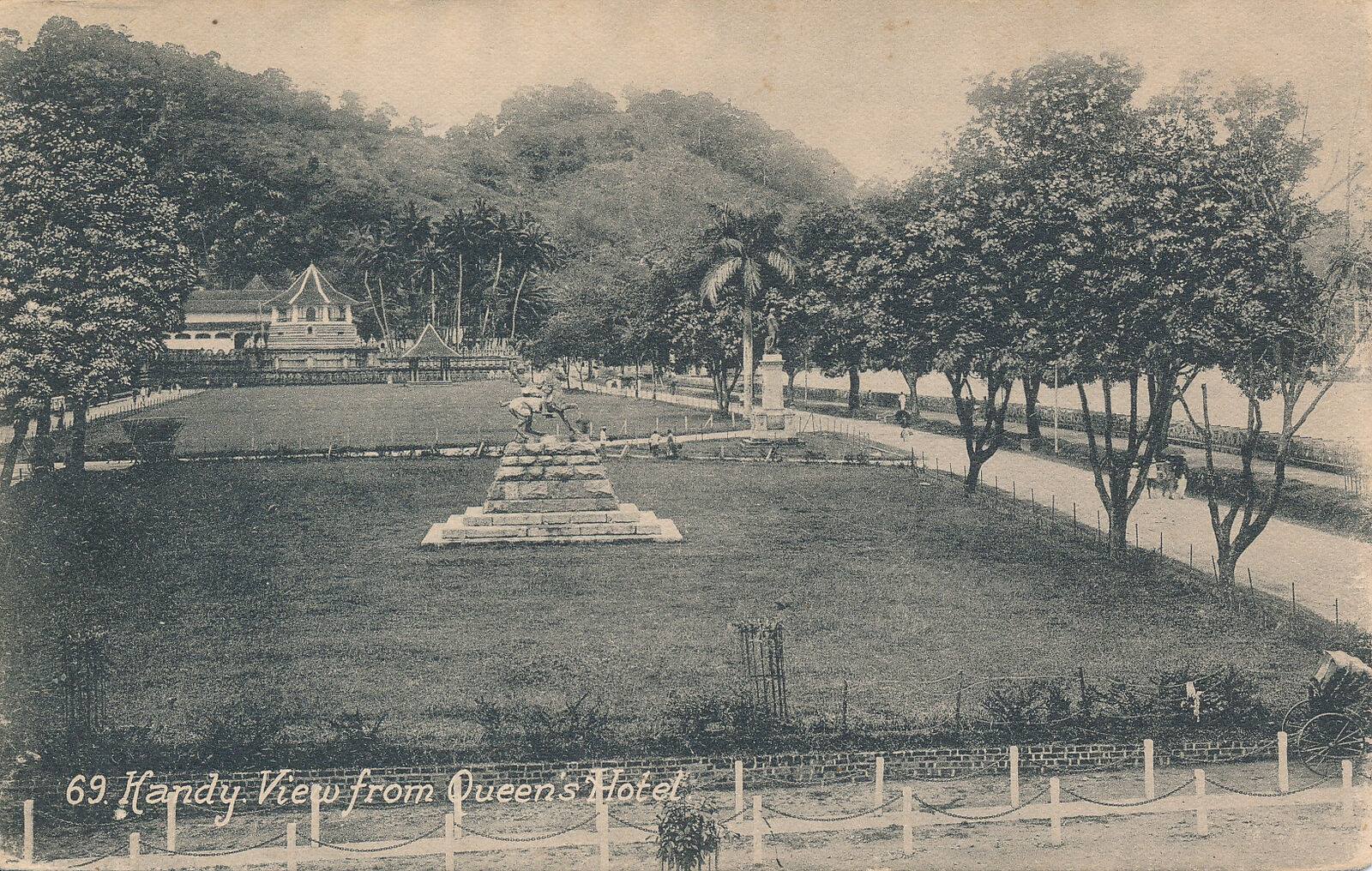A Boy-Priest and His Cook
දඹුළු ලෙන වගේ, ඒත් කුඩා ලෙනක්, කුරුණෑගල ගල් පර්වතයේ අඩක් දුර නැග්ගම දැකගන්න පුළුවන්. එහි වැඩ වාසය කරන්නේ වයස අවුරුදු 13ක වගේ ළමා හිමිනමක්. හිස මුඩු කරගෙන, නිකන් පයින්ම ඇවිදිමින්, කහ පැහැ සිවුරක් බොහොම සිත්ගන්න සුළු විදිහට පොරවාගෙන සිටි මේ භික්ෂු නම, බොහොම ගෞරව සිත් පෙරදැරිව විහාරයට තම සේවාව ඉටු කළා.
 |
| Buddhist Priest and Young Pupils photographed by Plate & Co. [Image Courtesy: www.imagesofceylon.com ] |
පොඩි හාමුදුරුවෝ සහ ඔහුගේ ඇබිත්තයා
ඔහුට ආවතේවකම් කරමින් අවුරුදු නමයක වගේ කුඩා ඇබිත්ත කොලුවෙකු (පෙරදිග සෑම හිමි නමකටම ඇබිත්තයෙකු සිටී) දකින්න ලැබුණා. පේන විදිහට නම් මේ කොල්ලා තමයි මෙතන කෝකියා. පොඩි හාමුදුරුවන්ට උයා පිහා දෙන්නේ ඔහු. මේක නම් ටිකක් සුඛෝපභෝගී තත්වයක්. ඒත් ප්රතිපත්තියක් විදිහට බෞද්ධ හිමිවරු ගත කරන්න ඕනි කෑමෙහි පමණ දත් අල්පේච්ඡ ජීවිතයක්. කියන විදිහට නම් මුදල් භාවිතයක් තියෙන්න බැහැ. තමන්ගේ කියා දේපල වස්තු තියෙන්න බැහැ. සම්පූර්ණයෙන්ම බ්රහ්මචාරී ජීවිතයක් ගත කරන්න ඕනි.
 |
| Buddhist Vihara at Maligakanda [Image Courtesy: www.lankapura.com ] |
සෑම උදෑසනකම ඔවුන් දෛනික ආහාර වේල සඳහා පාත්රයත් අතින් ගෙන පිණ්ඩපාතෙ වඩිනවා. ඔවුන් නිවසක් ළඟට ගිහින් දොර ඉස්සරහා සිටගෙන ඉන්නවා. ඒත් මුකුත් ඉල්ලන්නේ නැහැ. ඊට පස්සේ කාන්තාවක් නිවසින් පිටතට ඇවිත් හාල් පොඩ්ඩක් මේ පාත්රයට දමනවා. හිමිනම ඊළඟ ගෙදරටත් මේ විදිහට වඩිනවා. ප්රමාණවත් තරමට දේවල් ලැබුණම ඔහු ආපසු විහාරය කරා එනවා. ඔහුගෙ ඇබිත්තයා ඒ ආහාර පිසිනවා (ආහාර පිස නැතිනම්). ඔහු එය තමයි ආහාරයට ගන්නේ.
සෑම හිමි නමකටම තමන්ගේ කියලා ඇබිත්ත කොල්ලෙක් තියාගන්න නිදහස තියනවා. නමුත් ඔහුව පුහුණු කරන්න ඕනේ අනාගතේ භික්ෂුවක් වෙන්න, තමන්ගෙන් පස්සේ තමන්ගේ තැන අරගන්න. සමහරක් විට මේ කුඩා කෝකි කොලු ගැටයා මෙහෙම ඉන්නේ ඒ කාරණාව හන්දා වෙන්න පුළුවන්.
 |
| The Buddhist Priests and Colonel Olcott in Colombo (1883) |
අනෙකුත් බෞද්ධ විහාරාරාම
බෞද්ධ හිමිවරු, හින්දු පූජකයන් වගේම බොහෝ විට නූගත් ජනයා අතරින් තමයි බිහිවෙන්නේ. ඒත් එයාලට නම් බ්රහ්මණ කුලයක වියයුතුයි කියා දෙයක් නැහැ.
 |
| Henry S. Olcott and the Ven. Hikkaduwe Sumangala Thero, Colombo, 1889. [Image Courtesy: http://www.cwlworld.info/html/bio.html ] |
 |
| Sumangala Thero's Vidyodaya Piriwena, Maligahakanda |
 |
| Priests and Villagers at Funeral Pyre at a Cremation of a Buddhist Priest (Ceylon ca. 1900) [Image Courtesy: www.imagesofceylon.com ] |
 |
| Colombo - Kandy Mail Coach (ca.1860) [Image Courtesy: www.imagesofceylon.com ] |
“ආදම්ගේ ශිඛරය මතින් එලිෆන්ටා ගුහා වෙත – ලක්දිව සහ ඉන්දියාවේ රූප සටහන්” : එඩ්වඩ් කාපෙන්ටර්
පස්වන පරිච්ඡේදය : බ්රිතාන්යය නීති පද්ධතිය සහ බෞද්ධ සිද්ධස්ථාන.
There is a little one of this kind half-way up the rock at Kurunegala, and it is tended by a boy priest of about thirteen years of age, who, barehead and barefoot, but with his yellow priest-robe wound gracefully about him, attends in a dignified manner to the service of the shrine. He is generally followed by a little attendant (every one has an attendant In the East)—a small boy of about nine — who turns out to be his khoki, or cook! This sounds luxurious, but by rule the Buddhist priests should live the most abstemious lives. They are supposed to have no money or possessions of their own, and to be entirely celibate. Each morning they go out with their begging bowls on their arm to get their dally food. They go to a house and stand near the door, asking nothing. Then presently the woman comes out and puts a little rice In the bowl, and the priest goes on to the next house. When he has got sufficient he returns, and his attendant cooks the food (If not already cooked) and he eats it. For each priest has the privilege to choose a boy or youth to be his attendant, whom he trains up to the priesthood, and who takes his place after him. This perhaps explains the presence of the small boy khoki above.
After looking at the Dambulla temples, which are said to have been constructed by the king Walagambahu about 100 B.C., we gained the summit of the rock, whence you have a view over plains towards the sea and of ranges of hills inland, not unlike that from the rock at Kurunegala ; and then descended, not without difficulty, the precipitous side. Evening fell, and darkies came out with lamps to our aid.
The same night I pushed on by mail-coach to Anuradhapura, leaving Modder behind, as he unfortunately had to return to Kurunegala the next day.





Comments
Post a Comment